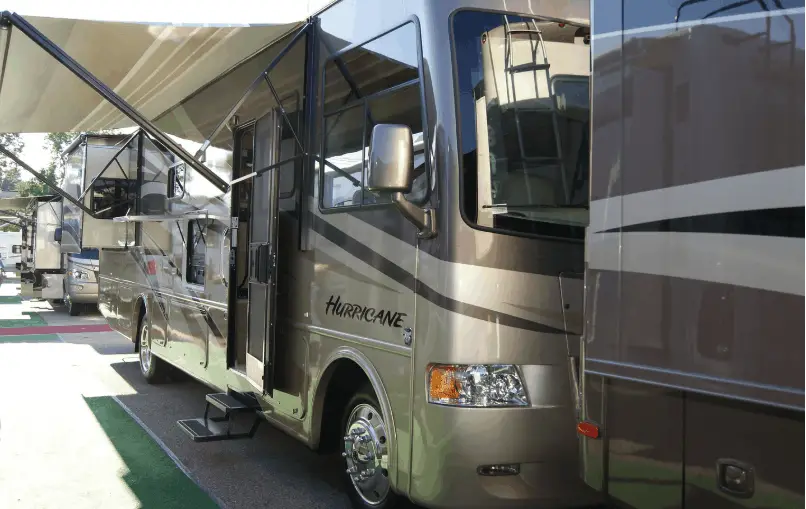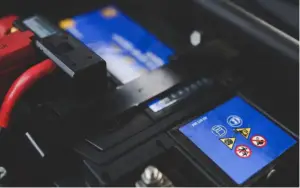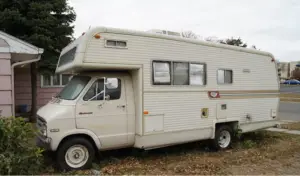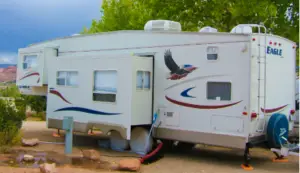Your RV awning can provide you the much-needed shade to keep cool on a hot summer day. RV awnings are perfect for enjoying reading, relaxing, and spending some time amidst nature with your family and friends.
Therefore, it is essential to keep your RV awnings in good condition. Awnings usually do not require tons of maintenance. However, there are few things you can do to protect them and prolong their life.
What is the best material for RV awnings?
Several materials are used to make RV awnings with different functionalities. Each kind of awning has its advantages and downsides. But, the most common materials used to make RV awnings are acrylic and vinyl.
Acrylic awning
Acrylic awnings are more durable and also offer an appealing design. They repel water but are not waterproof, so water can seep through. Acrylic awnings resist mildew but are not mildew proof.
They can tolerate wear and tear due to the ultraviolet light. Acrylic fabric awnings are made of woven cloth and allow better circulation of air through the fabric. They can easily endure freezing ice, snow, strong winds, dirt, dust, bugs, anything you can think of.
Acrylic awnings dry out quickly and can be rolled up when wet. The colors on the acrylic fabric are woven in and not painted. Thus your awning will surely remain bright over the years.
Vinyl awning
Vinyl awnings are heavy and more translucent. They can handle the burning sun as well and are waterproof. Vinyl awnings are scratch and fade-resistant. They are light and stay tight on the frame.
But vinyl awnings are not breathable. Thus, the temperature under the canopy does not stay as cool as is the case with acrylic awnings.
Vinyl awnings are also susceptible to mold and mildew. They attract dirt and dust and are less effective in humid areas.
How to prevent the RV awning from damage?
A well-maintained awning can provide you many years of trouble-free operation. They will allow you to eat and relax in its shade as you enjoy the views at your campground. The following tips can be helpful in preventing your RV or motorhome awning from any damage.
1. Don’t stow away the awnings when wet
Never store a damp awning as that can lead to the growth of molds and also ruin the fabric. Let it dry out before packing it. Vinyl fabrics are resistant to mildew but are not necessarily mildew-proof.
So mildew can form in the dirt that collects on the vinyl awning. Storing the awning wet can escalate the growth of mold, especially in high humidity and high-temperature areas.
2. Regular cleaning with a soft detergent
Using harsh detergents or over-washing can wear down the fabric and also the mold-resistant and UV rays resistant coat on the material. Use only professional products to wash your awnings that give extra protection against the scorching sun.
Wash your awning when necessary, and not frequently. Usually, light sprays from a hose are sufficient to get rid of any debris from your awnings. If you see any stains and spots, then scrub them out gently before rinsing to prevent the protective waterproof layer from getting eroded.
3. Use a wind protector
Sometimes when winds pick up, your awnings are at a significant risk of wear and tear. Constant flapping can also tear the bead that fixes the fabric to the rail of the RV. If this bead becomes loose, you will have to replace your entire awning.
Therefore, to avoid this, install a wind protector to help stabilize your awnings so that they can withstand strong winds. Installing a wind protector can also curtail the noisy whipping of the awning.
4. Roll them up during travel and when, not in use
Make sure your awnings are securely fastened and locked during transit. Roll it up when it rains, at night, or when you are away.
Securing your awning in place when you are moving can prevent it from opening and getting ripped off when the RV is moving at high speed.
It is advisable to roll up your awnings at night before going to bed. It could snow or rain at night, or strong winds can start blowing, which can cause damage to your awning by the time you wake up in the morning.
When you are not using your awning for shade, stow it away to curtail the damage from the sun.
After it has rained, position one side of the awning a little lower than the other side to allow the water to run off instead of getting collected in the center. Pooled water can cause your awning to wear faster than usual.
5. Lubricating the awning
If you want to keep your awning looking good, then lubricating the arms of the awning is a great idea. Lubricating can make sure that the awnings retract and extend quietly without any squeaking noise and also keeps the moving parts maintained.
6. Regular inspection of your RV awning
Despite proper care and maintenance, your RV or travel trailer awning will wear over time. It is vital to inspect your awning at least twice a year thoroughly to avoid any potential issues.
1. Check the awning end caps carefully for any broken or missing rivets or any other signs of damage. Look for damaged rivets or enlarged holes in the handles.
2.Extend the awning, check all the mechanical parts such as the roller tube for any signs of warping.
3.Check if your awning makes any unpleasant noises or clicking or if there is any resistance while opening and closing it.
4.Make sure the mounting hardware is correctly attached to the camper or motorhome.
5.When the awning is locked away, check the locking mechanism by gently pulling at the awning to see if it can open while being locked. If the safety-lock mechanism is working correctly, the awning should not move at all.
How much wind can RV awning handle
Several factors can determine whether your awnings will be able to handle strong winds, such as the type and size of the awning. But still, it is advisable to put your awning away if the winds are too intense.
Electric awnings can’t take strong winds, and strong winds can wreak havoc on them. The manual awning can withstand winds up to 20 MPH, whereas you may have to retract your electric awning at 5MPH.
You can take the arms of manual awnings off and stake it to the ground. But sometimes even mechanical awnings can’t withstand extreme winds. Your awning fabric can rip away from the track that secures it to the side of your motorhome.
Even wind protectors cannot guarantee that your awning remains unharmed in high winds but can only provide a bit of a safety cushion when you forget to roll up the awning, and the wind picks up speed.
How to keep RV awning dry
You do not want to roll up your awning when it is still wet, a that can heighten the chances of getting mildew, or the fabric can also get deteriorated over time. So if your awning is wet, allow it to dry out in the sun entirely on both sides before you roll it up.
Sometimes despite rolling up the awning when completely dry, there is a possibility of water getting inside them when it rains. Therefore it is a good idea to roll out and extend your awnings once a month to air them.
It is imperative to keep the awning fabric as clean a possible so that there are lesser chances of mildew formation on any residue of dirt and dust.
Adjusting fabric on RV awning
If your RV awning does not roll up and down straight or if it struggles to roll up tightly, there could be some tension that has to be adjusted. Sometimes the fabric can also get stretched over time either due to heavy rain or pooled water on it that prevents the awning from rolling up evenly.
Replacing the fabric is the only solution in this case. The other reason could be that the awning may have shifted forward or rearward.
The top portion of the awning should remain secure, and not shift to one side. When that top portion moves into the awning rail, the awning will wind up crooked.
The awning arms both at the fore and the rear should be parallel to each other and run perpendicular to awning rail itself.
There could be a loose screw, or maybe the manufacturer forgot to put a locking screw on the awning bead, and therefore, it slides into the rail. The screw keeps the fabric from slipping into the awning rail at the roofline.
If you find this screw missing, then roll down the awning and pull on the fabric at the roof rail to bring it between the two rafter or upper brackets. Then fix a self-tapping screw to fix the bead from shifting.
How to clean RV awning and how often to clean
Always pick a sunny day to clean your awning. It would need the sun to dry it out once you have cleaned it off.
Now take an awning cleaner, or you can also clean your awning with soap and water.
Make a cleaner mix, by diluting two parts of the cleaner with eight parts of water.
Do not use bleach to clean your awning as it can reduce the life of your awning.
In case you have to use bleach to remove tough stains, then always mix it with water before putting it on the awning. When your cleaning mixture is ready, spray it all across your awning, both top and bottom.
Now roll up your awning and allow the cleaning mixture to sit there for approximately an hour. After you have waited for an hour, unroll the awning and take a hose to rinse it off top and back. If you see any spots or stains, then scrub them using a brush.
You can also use white vinegar to get rid of stubborn stains and to kill the mildew. If you are cleaning your awnings after a long time, then scrub both the top and the bottom properly. Make sure to get off all the soap from the awning.
The last step is the most important. Its letting your awning stay open so that the sun can dry it. If you head out on RV trips quite often, then you should clean the awnings four to five times a year.
Like everything else in your RV, your RV awnings also require periodic checks and maintenance to keep them functioning correctly. Your RV awning can instantly provide you a breezy respite on a hot sunny day and creates a beautiful outdoor space.
Maintaining your RV awning will not just give an excellent outdoor extension to your RV but could also save money on getting a new awning.





